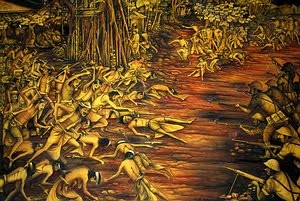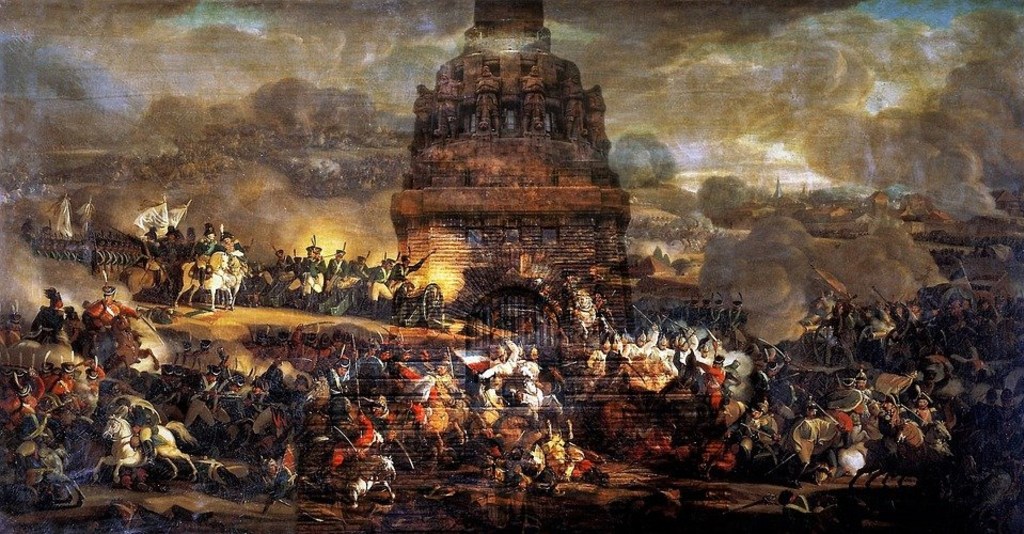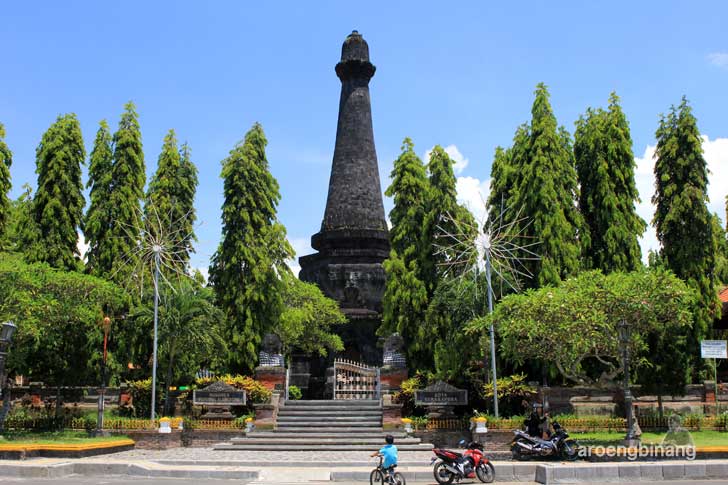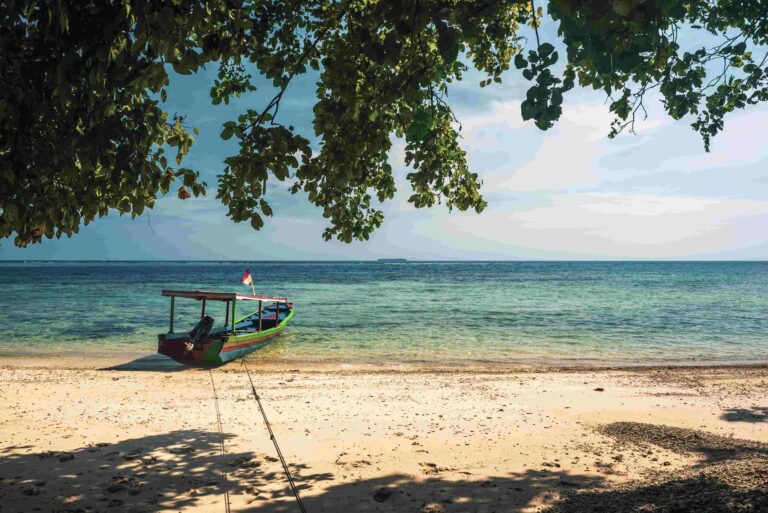Puputan is a symbol of resistance, and heroism and a painful reminder of the Dutch colonial rule and successful war against Balinese kings.
This non-boring history guide will offer you a glimpse into the suffering and unity of Balinese people in the face of enemies throughout the island’s history.
What Is Puputan?
Puputan is an Indonesian word (to be precise, Balinese word) meaning “to come to an end,” and it describes a ritual involving mass suicide that Balinese warriors and kings chose in order not to surrender to Dutch troops.
It could also mean the last desperate attack when the enemy army is exceeding in numbers. That attack might as well end in mass suicide.
To perform puputan, Balinese rulers dressed in white outfits for cremation, usually led the silent procession outside the palace, then at some point they would stab themselves in the chest with Balinese ceremonial dagger – Kris.
In a way, this grim Balinese tradition reminds us of the Japanese seppuku.
How It Happened: The War History Of Balinese Kingdoms

Bali was the last island to fall under the weight of the Dutch colonial rule.
The two most important puputan rituals happened in 1906 and 1908. However, there were a total of 5 puputan moments in the history of Bali from the 18th to 20th centuries.
Puputan Jagaraga
Puputan Jagarag, the second puputan war in Indonesia and the first Balinese puputan war happened in the middle of the 19th century (1848-1849) between Dutch forces and the northern kingdoms of Buleleng and Karangasem.
XII King of Buleleng, Gusti Ngurah Karangasem and his prime minister I Gusti Ketut Jelantik signed a peace treaty with the Dutch in 1846. Over the years, the king didn’t fulfil the requirements of the agreement and knowing war was coming, they moved the capital to Jagaraga.
Jagaraga Fortress had amazing defence and attack position and the king trained more soldiers and gained the support of other kingdoms. The Balinese people also cut off the Dutch food supply and regularly raided their ships.
Tired of that, in 1848, Dutch ships sailed to Bali. They didn’t expect so much resistance from Balinese troops and eventually had to retreat.
They came back a year later, in 1849, well-prepared and marched straight to Jagaraga. This time, a bloody battle ended with the king’s suicide alongside 400 of his followers.
Puputan Kusamba, 1849

The second puputan war aka Perang Bali III or Perang Kusamba happened in Bali between 1849 and 1850 in Southern Bali.
In 1846 and 48 two Dutch attempts to seize the South Bali failed, and in 1849 it was the time for the third. The conflict sparked after an armed “negotiation” in Singaraja between the Dutch and the kings of Klungkung and Karangasem where the Balinese rulers refused to abandon the old Balinese tradition of appropriating the wrecked ships – tawan karang.
The king of Klungkung, I Gusti Ngurah Made Karangasem, and his prime minister, I Gusti Ketut Jelantik waited with the soldiers just outside Kusamba. The battle was violent and when the Dutch troops reached the palace they found the procession and the royal family dead by suicide.
Puputan Badung, 1906
September 1906 is when South Bali and two of the strongest Balinese kingdoms, Badung and Tabanan, fell, weakening all the remaining independent kingdoms. It was the 4th Puputan War In Bali.
After the Dutch took the North Bali, they moved south – where they had the most resistance. Over the course of the years, they managed to make the Gianyar kingdom adopt their law system and improve the infrastructure and trading practices.
In particular, the Dutch asked Balinese rulers to stop taking over foreign wrecked trading ships as it went against the law. In 1906, the Bandung king ignored the rule and looted a wrecked Chinese ship in Sanur.
The sequence of events triggered another war, and a massive Dutch army pushed Balinese soldiers through Kesiman kingdom (where the king refused to fight the Dutch and was killed by the royal priest), all the way to Denpasar.
Once arrived, the Dutch realized that the king of Badung – Raja, had decided to commit mass suicide with the court followers. Everyone was ceremonially dressed in white for cremation and stubbed themselves with kris, a magic Balinese dagger.
This was followed by open fire from the Dutch. Around 1000 people died, and the palace was burned down.
Tabanan royal family surrendered at first. The Dutch offered them an exile, but a few days later, the king performed puputan.
Puputan Klungkung, 1908
Dutch were advancing through the island, and one of the last remaining independent kingdoms was Klungkung. There are two versions of why the conflict started.
First: In 1908 Dutch soldiers crossed the borders of the Klungkung kingdom which immediately triggered a reaction from the Balinese – they killed the patrol.
The Dutch didn’t like it and gave the king an ultimatum: surrender or die. Dewa Agung Jambe II, the king of Klungkung, refused and the 5th Puputan War started.
Second: In 1908 there was a Dutch attempt to monopolize the opium trade between Java, Bali, and beyond. A few kingdoms, including Klungung, didn’t agree with that and started protests. Dutch troops then decided to kill those who they could catch and drop bombs on Klungkung.
Balinese had all the fierceness and courage, but the Dutch army simply had guns versus spears and handmade guns Balinese soldiers had. The numerically superior enemy left only one option for the royal family and their followers – puputan.
The whole royal family including children and wives, many officials, and court members died on the 18th of April, 1908 in front of the Klungkung palace. They all committed suicide by stubbing themselves with ceremonial daggers but Dutch forces also shot at every single one of them.
This was probably one of the most iconic heroic acts performed by the Balinese rulers as it also marked the fall of the last standing kingdom.
Puputan Margarana, 1946

After WWII, Indonesia was eager to become sovereign as a nation, but the Dutch returned so Indonesian republicans had to fight for independence.
Colonel I Gusti Ngurah Rai was the commander of the Indonesian People’s Security Army. Unfortunately, the army was heavily outnumbered by the Netherlands Indies Civil Administration (NICA) but didn’t surrender.
The troops and commander performed puputan in November 1946 in the village of Marga. The colonel is a national hero, as are all the soldiers.
Comemerotative Puputan Monuments In Bali
As there were a few puputan rituals performed in different kingdoms, each has its own memorial. The memorial mostly consists of a tall phallus-shaped monument, and often there is also a smaller monument with Balinese soldiers or families with spears and in a heroic pose.
Usually, every village has its own traditions and dates for annual celebrations.
Visiting any of them, make sure to take a local guide with you to learn stories of descendants and the real history of each event.
Puputan Jagaraga Monument

Located right in the village of Jagaraga in Buleleng, it is a big monument in honour of the courage, self-devotion, and resistance of Balinese people during the Second Puputan War.
There are two main statues of I Gusti Ketut Djelantik and Jro Jempiring – war heroes, towering over the square, and more statues of warriors around it.
Underneath, there is a memorial room recounting the story of the Jagaraga war.
Where Is It? V5V5+QF6, Jagaraga, Sawan, Buleleng Regency, Bali 81171, Indonesia
Puputan Square Denpasar
To commemorate the tragic fall of the Badung kingdom and puputan performed by Badung soldiers, the king and his followers, there is a park in the centre of Denpasar – Taman Puputan.
It is a splendid urban area with a green park. There is an enormous monument in the centre and another monument with a Balinese family standing proudly with spears. The woman also holds some jewellery in her left hand, as the women in puputan processions often threw jewellery at the Dutch soldiers.
Today, the park is where families bring children to spend time on the playground, have lunch or late-night snacks, hang out by the pond, or fly kites.
In literature, it was mentioned in the novel Love and Death in Bali by Vicki Baum.
Where Is It? Dauh Puri Kangin, Denpasar Barat, Denpasar City, Bali, Indonesia
Puputan Klungkung Monument

Visitors can still explore what’s left of the Klungkung Palace and its pavilions and visit the Puputan monument and the memorial near the palace.
When you visit the palace and the village, you will see a massive field. It is the very place where the mass suicide took place.
Underneath the Puputam monument, you will find a memorial room with a historical diorama.
Where Is It? FC83+397, Central Semarapura, Klungkung, Klungkung Regency, Bali 80761, Indonesia
Puputan Margarana Monument
This War Memorial is probably one of the most impressive.
Not just a monument but rows and rows and rows of gravestones commemorating those who stood up bravely against the Dutch in 1946, knowing that their forces were largely outmatched.
It leaves a deep impression on everyone who visits.
Where Is It? G5M7+XFX, Kelaci, Marga Dauh Puri, Marga, Marga Dauh Puri, Kec. Marga, Kabupaten Tabanan, Bali 82181, Indonesia
Final Thoughts On Puputan
Balinese heroes repeatedly opted for a noble death over surrender and it influenced a lot the character and the devotion of Balinese people who fought for independence.
These dark pages of history are embedded in the Balinese culture and one can’t fully understand the people without knowing their pain.
Read more:
There Are Only Four Balinese Names? The Balinese Naming System Explained
Tri Hita Karana: The Key To Harmonious Relationships In Bali
Pancasila Day: The Day Celebrating The Five Principles Of The Indonesian Nation








